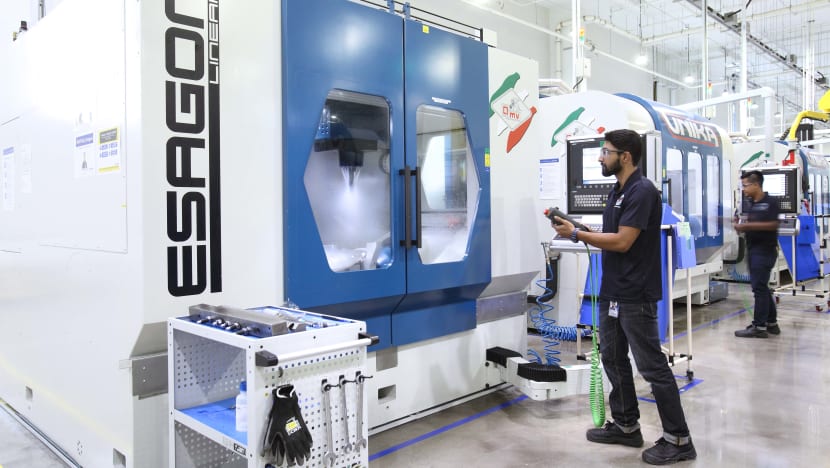US aerospace firm Pratt & Whitney to hire another 250 employees in Singapore as it prepares for recovery

American aerospace manufacturer Pratt & Whitney is looking to hire another 250 employees in Singapore by the end of this year, with more positions to come in 2022. (Photo: Pratt & Whitney)
SINGAPORE: American aerospace manufacturer Pratt & Whitney is looking to fill around 250 jobs in Singapore by the end of this year, with more positions to come in 2022, as it readies itself for a recovery from the COVID-19 pandemic.
The firm is also stepping up on hiring in China, where it has an engine centre in Shanghai, but its “largest hiring strength right now is in Singapore”, said Mr Tim Cormier, vice-president of aftermarket operations in Asia Pacific.
A majority of the job roles are production associates, such as engine maintenance technicians, repair technicians and inspectors. It is also on the hunt for more engineers, material handlers and supervisors.
The recruitment process started about two months ago with walk-in interviews and recruitment fairs. The company also reached out to institutes of higher learning to recruit students graduating next year.
“We are still going through our estimates for 2022 but we would expect (hiring) to continue on through into next year,” said Mr Cormier.
“ON A PATH TO RECOVERY”
Pratt & Whitney’s hiring spree comes slightly more than a year after the aircraft engine maker laid off 400 employees across five of its facilities here.
The “difficult but necessary” decision was announced in August last year, with the company citing “a prolonged recovery timeline for commercial aviation” amid the COVID-19 pandemic.
It was not the only aerospace company to have retrenched workers in Singapore. Other multinationals like Airbus and Rolls-Royce made similar moves last year as the industry reeled from the dearth of global air travel.
Pratt & Whitney has been operating in Singapore since 1983 and currently employs nearly 2,000 people.
Asked if last year’s retrenchment was a hasty decision given how it is looking to hire again in a year, Mr Cormier said: “I don't think it was hasty. I think when you go back to that time period, we were looking at the best forecasts that we had at the time and if you recall, the aerospace utilisation or aerospace market dropped by about 80 per cent.
“And when we look at the overall recovery, we're still on the same trajectory that overall as a company and overall as an industry we’ve been on all along, which is a recovery to pre-pandemic utilisation by 2024.”
But the company has seen “some additional strength” in areas, such as global air cargo demand.
“That is one area that we didn’t completely anticipate to be as strong as it is … Cargo is actually up above what we saw in pre-pandemic times so that recovery is already there,” said Mr Cormier.
Data from the International Air Transport Association (IATA) showed global air cargo traffic up 7.7 per cent in August, compared with the same month in 2019, due to robust manufacturing production and export orders.
Mr Cormier said: “When you look at the portfolio that we have at ESA (Eagle Services Asia) and some of the other repair units, there’s a lot of strength that we see and some volume-related growth there. So that's been a really bright spot for us.”
Apart from Asia Pacific, the company’s aftermarket business in Singapore also serves cargo operators and carriers from the US and European markets, he added. “So that's been a bit of an upside for us.”
Another area that saw some strength amid the pandemic was the utilisation of narrow-body jets, said Mr Cormier, especially as domestic travel for both business and leisure starts to resume in some countries like China and the United States.
Engines made by Pratt & Whitney are used in several of these smaller jet types, such as the Airbus A320neo aircraft.
Moving forward, the launch of vaccinated travel lanes between countries is providing “an early glimpse into how international traffic will be headed”, said Mr Cormier.
Improvements in vaccination rates globally also provide “some confidence” in the world’s ability to cope with the spread of the more infectious Delta variant and even the possible emergence of other COVID-19 variants, he added.
Asked if the worst is over for his industry, Mr Cormier said: “I would say that going back to March, April and May of 2020, those were some really rough times and as a result … all sectors, not just aerospace, were forced to take some very difficult actions.
"So it does feel like we are on a path to recovery."
As such, Pratt & Whitney is taking early actions to be ready.
“While there may be some hiccups, some downturns or upturns – generally we are on plan. But in order to be ready for 2024, we need to make sure that we have the right people in place,” said Mr Cormier.
This includes having the right on-the-job training programmes and certifications for its workforce.
“In other words, make sure that they are prepared for the work that is coming our way to ensure that we can (meet) the customer requirements,” he added.
INVESTING IN TECHNOLOGY
Apart from ramping up hiring to meet demand in growing areas, the new hires are also an opportunity to bring in people with different skills – such as in robotics and automation.
The company has been making use of the downturn to invest in new technologies that will automate repetitive processes and digitise its facilities. For instance, it introduced a collaborative robot to do the “mundane” task of taking photographs during an engine inspection.
“So rather than having an individual with a camera take a number of different photos and then upload them and document, you can actually have a robot do that,” Mr Cormier said.
“What's interesting about that is the skill set that's required is no longer an individual that is capable of taking pictures, but it’s an individual that's capable of programming that robot and working alongside it to ensure that we’ve got the right quality of the photos, the right locations et cetera.”
The company declined to reveal how much it has spent on these new technologies.
Mr Cormier told CNA: “I would like to see ourselves as being the most competitive MRO (maintenance, repair and overhaul) business in the world by the time we get to that full recovery in 2024.
“So part of that is investing in our facilities and it’s ensuring that we are modernising our facilities and ensuring that we’ve got the right technology in order to meet those customer demands.”


















